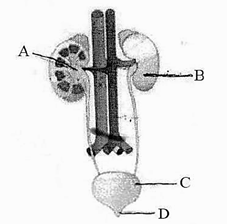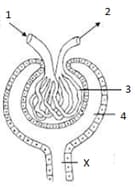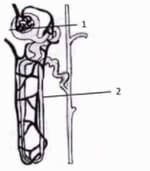The blood is thicker in arterioles as compared to efferent arterioles.
Important Questions on Excretory Products and Their Elimination
The given part belong to which system?
(a) Kidneys (b) Ureters (c) Urinary bladder
Draw a neat labelled diagram of the system.
The diagram given below represents an organ system in the human body. Study the same and answer the questions that follow:

(i) Identify the system.
(ii) Label the parts marked 2 and 4. Mention the function of part 5.
(iii) Name the structural and functional units of the part marked 1.
(iv) What is the fluid that accumulates in part 3? Which is the main nitrogenous waste present in it?
(v) Draw a neat, labelled diagram showing the longitudinal section of part 1.
Identify in the below diagram of the excretory system of man.

The figure given below shows a part of a nephron.
Answer the questions that follow:

(i) In which region of the kidney is the above structure present?
(ii) Label the parts numbered 1 to 4.
(iii) What is the technical term for the process that occurs in part 3?
(iv) Why is fluid X not called urine? Justify your answer.
(v) Draw a neat, labelled diagram of the urinary system of man.
Choose the correct answer from the four options given below:
The structural and functional units of excretion in the human kidney is the:
The diagram given below is that of a structure present in a human kidney. Study the same and answer the questions that follow:
Name the structure represented in the diagram.
Consider the following three statements with blanks. Which of the options correctly fills all the blanks in these statements?
a) The ascending limb of loop of Henle's is impermeable to __(1)__ but allows transport of __(2)__
b) __(3)__ and __(4)__ play a significant role in producing a concentrated urine.
c) A fall in the glomerular blood flow/glomerular blood pressure / GFR gets active at the JG cells to release __(5)__
Reason They are protruded into the body cavity from inner surface of dorsal body wall and have mesodermal peritoneum on their ventral side only
Study the following table.
| Part of Nephron | Location | Function | |
| A | Malpighian body | Cortex | Filtering blood |
| B | Proximal convoluted tubule | Cortex | Absorption of useful substances |
| C | Distal convoluted tubule | Medulla | Absorption of urea |
| D | Collecting duct | Only Cortex | Collection of urine |
Identify the correct combinations among the above.
Study the following table
| S.No | Part of nephron | Lined by | Substances reabsorbed |
| I) | Proximal convoluted tubule | Simple squamous epithelium | Glucose, amino acids, water |
| II) | Descending limb of loop of Henle | Squamous epithelium (thin layer) | Water |
| III) | Ascending limb of loop of Henle | Squamous epithelium (lower thin and upper thick) | Water, electrolytes |
| IV) | Distal convoluted tubule | Cuboidal epithelium | Water, |
Among the above, Wrong combination are
Differentiate between the following pairs on the basis of what is indicated in the brackets.
Ureter and Urethra [function]


